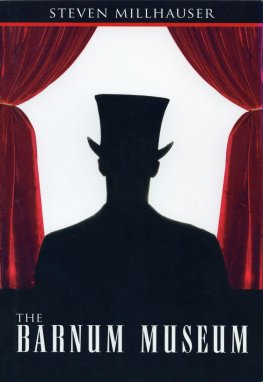Steven Millhauser - Eisenheim the Illusionist
Here you can read online Steven Millhauser - Eisenheim the Illusionist full text of the book (entire story) in english for free. Download pdf and epub, get meaning, cover and reviews about this ebook. City: New York, year: 1994, publisher: Atlantic Monthly Press, genre: Prose. Description of the work, (preface) as well as reviews are available. Best literature library LitArk.com created for fans of good reading and offers a wide selection of genres:
Romance novel
Science fiction
Adventure
Detective
Science
History
Home and family
Prose
Art
Politics
Computer
Non-fiction
Religion
Business
Children
Humor
Choose a favorite category and find really read worthwhile books. Enjoy immersion in the world of imagination, feel the emotions of the characters or learn something new for yourself, make an fascinating discovery.
- Book:Eisenheim the Illusionist
- Author:
- Publisher:Atlantic Monthly Press
- Genre:
- Year:1994
- City:New York
- ISBN:978-0871134837
- Rating:4 / 5
- Favourites:Add to favourites
- Your mark:
- 80
- 1
- 2
- 3
- 4
- 5
Eisenheim the Illusionist: summary, description and annotation
We offer to read an annotation, description, summary or preface (depends on what the author of the book "Eisenheim the Illusionist" wrote himself). If you haven't found the necessary information about the book — write in the comments, we will try to find it.
Eisenheim the Illusionist — read online for free the complete book (whole text) full work
Below is the text of the book, divided by pages. System saving the place of the last page read, allows you to conveniently read the book "Eisenheim the Illusionist" online for free, without having to search again every time where you left off. Put a bookmark, and you can go to the page where you finished reading at any time.
Font size:
Interval:
Bookmark:
Eisenheim the Illusionist
In the last years of the nineteenth century, when the Empire of the Hapsburgs was nearing the end of its long dissolution, the art of magic flourished as never before. In obscure villages of Moravia and Galicia, from the Istrian Peninsula to the mists of Bukovina, bearded and black-caped magicians in market squares astonished townspeople by drawing streams of dazzling silk handkerchiefs from empty paper cones, removing billiard balls from children's ears, and throwing into the air decks of cards that assumed the shapes of fountains, snakes, and angels before returning to the hand. In cities and larger towns, from Zagreb to Lvov, from Budapest to Vienna, on the stages of opera houses, town halls, and magic theaters, traveling conjurers equipped with the latest apparatus enchanted sophisticated audiences with elaborate stage illusions. It was the age of levitations and decapitations, of ghostly apparitions and sudden vanishings, as if the tottering Empire were revealing through the medium of its magicians its secret desire for annihilation. Among the remarkable conjurers of that time, none achieved the heights of illusion attained by Eisenheim, whose enigmatic final performance was viewed by some as a triumph of the magician's art, by others as a fateful sign.
Eisenheim, n Eduard Abramowitz, was born in Bratislava in 1859 or 1860. Little is known of his early years, or indeed of his entire life outside the realm of illusion. For the scant facts we are obliged to rely on the dubious memoirs of magicians, on comments in contemporary newspaper stories and trade periodicals, on promotional material and brochures for magic acts; here and there the diary entry of a countess or ambassador records attendance at a performance in Paris, Cracow, Vienna. Eisenheim's father was a highly respected cabinetmaker, whose ornamental gilt cupboards and skillfully carved lowboys with lion-paw feet and brass handles shaped like snarling lions graced the halls of the gentry of Bratislava. The boy was the eldest of four children; like many Brarislavan Jews, the family spoke German and called their city Pressburg, although they understood as much Slovak and Magyar as was necessary for the proper conduct of business. Eduard went to work early in his father's shop. For the rest of his life he would retain a fondness for smooth pieces of wood joined seamlessly by mortise and tenon. By the age of seventeen he was himself a skilled cabinetmaker, a fact noted more than once by fellow magicians who admired Eisenheim's skill in constructing trick cabinets of breathtaking ingenuity. The young craftsman was already a passionate amateur magician, who is said to have entertained family and friends with card sleights and a disappearing-ring trick that required a small beechwood box of his own construction. He would place a borrowed ring inside, fasten the box tightly with twine, and quietly remove the ring as he handed the box to a spectator. The beechwood box, with its secret panel, was able to withstand the most minute examination.
A chance encounter with a traveling magician is said to have been the cause of Eisenheim's lifelong passion for magic. The story goes that one day, returning from school, the boy saw a man in black sitting under a plane tree. The man called him over and lazily, indifferently, removed from the boy's ear first one coin and then another, and then a third, coin after coin, a whole handful of coins, which suddenly turned into a bunch of red roses. From the roses the man in black drew out a white billiard ball, which turned into a wooden flute that suddenly vanished. One version of the story adds that the man himself then vanished, along with the plane tree. Stories, like conjuring tricks, are invented because history is inadequate to our dreams, but in this case it is reasonable to suppose that the future master had been profoundly affected by some early experience of conjuring. Eduard had once seen a magic shop, without much interest; he now returned with passion. On dark winter mornings on the way to school he would remove his gloves to practice manipulating balls and coins with chilled fingers in the pockets of his coat. He enchanted his three sisters with intricate shadowgraphs representing Rumpelstiltskin and Rapunzel, American buffaloes and Indians, the golem of Prague. Later a local conjurer called Ignazc Molnar taught him juggling for the sake of coordinating movements of the eye and hand. Once, on a dare, the thirteen-year-old boy carried an egg on a soda straw all the way to Bratislava Castle and back. Much later, when all this was far behind him, the Master would be sitting gloomily in the corner of a Viennese apartment where a party was being held in his honor, and reaching up wearily he would startle his hostess by producing from the air five billiard balls that he proceeded to juggle flawlessly.
But who can unravel the mystery of the passion that infects an entire life, bending it away from its former course in one irrevocable swerve? Abramowitz seems to have accepted his fate slowly. It was as if he kept trying to evade the disturbing knowledge of his difference. At the age of twenty-four he was still an expert cabinetmaker who did occasional parlor tricks.
As if suddenly, Eisenheim appeared at a theater in Vienna and began his exhilarating and fatal career. The brilliant newcomer was twenty-eight years old. In fact, contemporary records show that the cabinetmaker from Bratislava had appeared in private performances for at least a year before moving to the Austrian capital. Although the years preceding the first private performances remain mysterious, it is clear that Abramowitz gradually shifted his attention more and more fully to magic, by way of the trick chests and cabinets that he had begun to supply to local magicians. Eisenheim's nature was like that: he proceeded slowly and cautiously, step by step, and then, as if he had earned the right to be daring, he would take a sudden leap.
The first public performances were noted less for their daring than for their subtle mastery of the stage illusions of the day, although even then there were artful twists and variations. One of Eisenheim's early successes was The Mysterious Orange Tree, a feat made famous by Robert-Houdin. A borrowed handkerchief was placed in a small box and handed to a member of the audience. An assistant strode onto the stage, bearing in his arms a small green orange tree in a box. He placed the box on the magician's table and stepped away. At a word from Eisenheim, accompanied by a pass of his wand, blossoms began to appear on the tree. A moment later, oranges began to emerge; Eisenheim plucked several and handed them to members of the audience. Suddenly two butterflies rose from the leaves, carrying a handkerchief. The spectator, opening his box, discovered that his handkerchief had disappeared; somehow the butterflies had found it in the tree. The illusion depended on two separate deceptions: the mechanical tree itself, which produced real flowers, real fruit, and mechanical butterflies by means of concealed mechanisms; and the removal of the handkerchief from the trick box as it was handed to the spectator. Eisenheim quickly developed a variation that proved popular: the tree grew larger each time he covered it with a red silk cloth, the branches produced oranges, apples, pears, and plums, at the end a whole flock of colorful, real butterflies rose up and fluttered over the audience, where children screamed with delight as they reached up to snatch the delicate silken shapes, and at last, under a black velvet cloth that was suddenly lifted, the tree was transformed into a bird-cage containing the missing handkerchief.
At this period, Eisenheim wore the traditional silk hat, frock coat, and cape and performed with an ebony wand tipped with ivory. The one distinctive note was his pair of black gloves. He began each performance by stepping swiftly through the closed curtains onto the stage apron, removing the gloves, and tossing them into the air, where they turned into a pair of sleek ravens.
Font size:
Interval:
Bookmark:
Similar books «Eisenheim the Illusionist»
Look at similar books to Eisenheim the Illusionist. We have selected literature similar in name and meaning in the hope of providing readers with more options to find new, interesting, not yet read works.
Discussion, reviews of the book Eisenheim the Illusionist and just readers' own opinions. Leave your comments, write what you think about the work, its meaning or the main characters. Specify what exactly you liked and what you didn't like, and why you think so.











